The streaming world is always changing, and currently, Spotify’s 2020 algorithm is the most sophisticated in predicting future listeners’ music. For the independent musician, understanding the music curation program that the Spotify algorithm utilizes is the first step to creating traction that does not involve paying for advertising. The more you can create your music engagement strategy matching the parameters of the algorithm, the more reach you will have in clouding excluded and real listeners.
1. Genuine Engagement
With the new algorithm, Spotify’s core principle of engagement is based on quality of listener engagement vs quantity of listener engagement. Does the listener save your song? That’s HUGE! Does your song get added to a playlist/save a number of the songs within that playlist? It’s even BIGGER! This is the engagement that the algorithm views as a positive sign your song is connecting with listeners. Be sure to use your tools to promote followers of your artist profile, save the songs they love, and tell their friends to follow them.
The more consistently and positively your listeners engage with you, the more Spotify’s algorithm views your songs should be recommended to similar listeners.
2. Quality Same First
Despite the number of tracks uploaded and streamed every day, the algorithm has taken a sharper focus on audio quality and the listener retention of that audio quality. The ingredients of clear production, and strong songwriting quality of your releases to create conditions for listeners to get to the “skipped” mark, is critical to improving your “completion rate” score. The longer the listener consumes your songs and artist, the more impactful your track ranks in Spotify’s recommender system thereby your song’s influential ranking will grow.
3. Enhance your Metadata and Artwork
Spotify utilizes accurate metadata to drive search and recommendation. Genre tags, descriptive track and album titles and artist bios go a long way to making sure your music appears in the right spots. Good artwork can help your music stand out and increase click-through rates on playlists and release radar features.
4. Build Steady Listening Patterns
The 2026 algorithm rewards sustained growth. Rather than dropping tracks and music intermittently, a consistent release calendar can help build that sustainable momentum. Aim for release schedules that feature EPs, singles or remixes. Regular uploads keep your profile fresh and remind Spotify you’re an active creator and worthy to include in algorithmic playlists such as Discover Weekly.
5. Use Playlists Organically
User-curated playlists are still important! Rather than aiming for enormous generic playlists, connect with smaller playlists that fit yours, and genre instead. When repeated plays come from true fans, Spotify sees this, and the algorithm may then impact your feature in other editorial playlists or algorithmic playlists multiplying your streaming and listenership.
6. Generate Traffic Inbound to Spotify
External buzz continues to matter. Every time a piece of content is socially shared, a video of a live performance, shared on music blogs, and so on, this will all create traffic to your music. The more listeners arrive to your track through separate surface channels and are engaged, the more the Spotify algorithm sees your track as culturally relevant, and the more likely you are to have it discovered organically.
Final Thoughts
Your chances of success on Spotify in 2026 will have less to do with hacks or TikTok, and more to do with the factors listed above and your ability to generate real fans. By focusing on engaged fans that you can develop, consistency in releases, and quality in production, you’re on the way to setting the algorithm up to work in your favor, and your music will reach the ears of listeners that want to fall in love with it.










